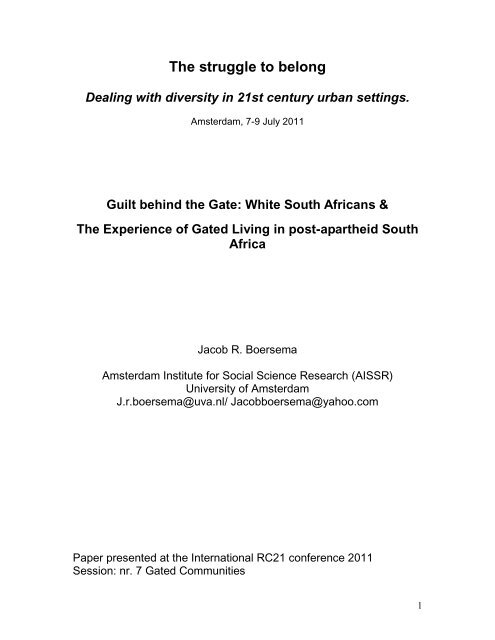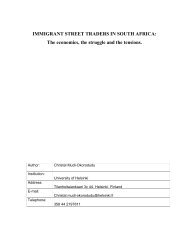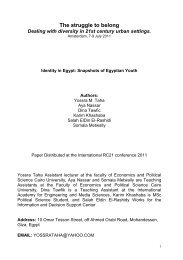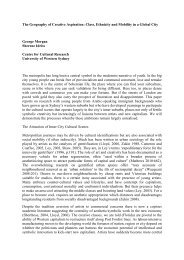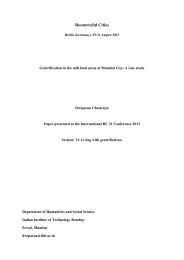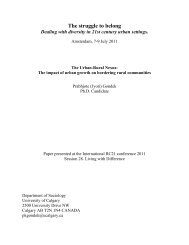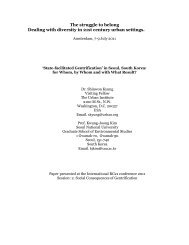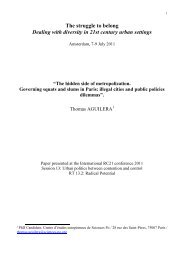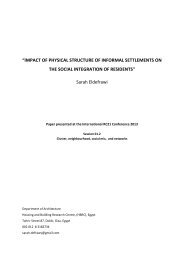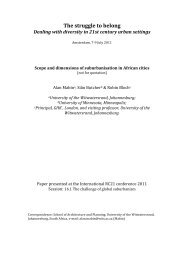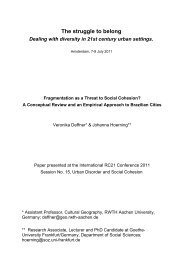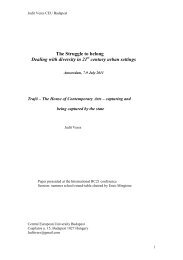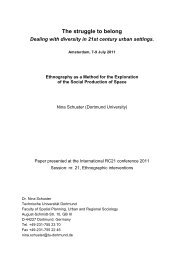White South Africans & The Experience of Gated Living in post ...
White South Africans & The Experience of Gated Living in post ...
White South Africans & The Experience of Gated Living in post ...
Create successful ePaper yourself
Turn your PDF publications into a flip-book with our unique Google optimized e-Paper software.
<strong>The</strong> struggle to belong<br />
Deal<strong>in</strong>g with diversity <strong>in</strong> 21st century urban sett<strong>in</strong>gs.<br />
Amsterdam, 7-9 July 2011<br />
Guilt beh<strong>in</strong>d the Gate: <strong>White</strong> <strong>South</strong> <strong>Africans</strong> &<br />
<strong>The</strong> <strong>Experience</strong> <strong>of</strong> <strong>Gated</strong> <strong>Liv<strong>in</strong>g</strong> <strong>in</strong> <strong>post</strong>-apartheid <strong>South</strong><br />
Africa<br />
Jacob R. Boersema<br />
Amsterdam Institute for Social Science Research (AISSR)<br />
University <strong>of</strong> Amsterdam<br />
J.r.boersema@uva.nl/ Jacobboersema@yahoo.com<br />
Paper presented at the International RC21 conference 2011<br />
Session: nr. 7 <strong>Gated</strong> Communities<br />
1
1.1 Introduction<br />
This paper addresses the question <strong>of</strong> how liv<strong>in</strong>g <strong>in</strong> a gated community is experienced by<br />
white Afrikaans women <strong>in</strong> <strong>South</strong> Africa. In the literature on neoliberal urban<br />
development, gat<strong>in</strong>g as a new development is <strong>of</strong>ten critically exam<strong>in</strong>ed because <strong>of</strong> its<br />
associated with issues such as privatization, fear <strong>of</strong> crime, racism, and the cont<strong>in</strong>uity <strong>of</strong><br />
white economic privilege (Blakely and Snyder 1997; Caldeira 2000; Low 2003). But do<br />
these different issues connect? And if so: how? That is <strong>of</strong>ten left unclear <strong>in</strong> the literature.<br />
Authors that have focused on such questions <strong>of</strong>ten use psychoanalytic theories to expla<strong>in</strong><br />
the strong emotions <strong>in</strong>volved <strong>in</strong> gat<strong>in</strong>g. But what k<strong>in</strong>d <strong>of</strong> new emotional landscape do<br />
gated communities create? Do such communities contribute to a fear <strong>of</strong> crime and fear <strong>of</strong><br />
the racial other, and if so, how? <strong>The</strong>se are the questions I will address <strong>in</strong> this paper and<br />
first explore <strong>in</strong> this theoretical <strong>in</strong>troduction.<br />
<strong>The</strong> phenomenon <strong>of</strong> gated communities has been extensively debated <strong>in</strong> the United States<br />
and more recently also <strong>in</strong> such countries as Ch<strong>in</strong>a, Brazil, and Turkey (Duncan and<br />
Duncan 2001; Duncan and Duncan 2004; Genis 2007; Glasze, Webster and Frantz 2006;<br />
Soja 2000; Wu and Webber 2004). Researchers have variously emphasized the legal,<br />
economic, architectural and life-style aspects <strong>of</strong> this trend. i <strong>Gated</strong> communities are <strong>of</strong>ten<br />
presented as the summon <strong>of</strong> neoliberal urban development and the trend <strong>of</strong> privatization<br />
and securitization. By def<strong>in</strong>ition, they are founded on a territorial, material basis that<br />
privatizes landscape through various mechanisms <strong>of</strong> appropriation and exclusion, private<br />
(<strong>in</strong>clud<strong>in</strong>g <strong>in</strong>stitutional) ownership, and local legislation (Low 2001).<br />
S<strong>in</strong>ce the abolishment <strong>of</strong> apartheid the gat<strong>in</strong>g <strong>of</strong> streets and communities has also<br />
exploded <strong>in</strong> <strong>South</strong> Africa. In the <strong>South</strong> African context, gat<strong>in</strong>g is also <strong>of</strong>ten discussed <strong>in</strong><br />
critical terms: it would symbolize the failure <strong>of</strong> racial <strong>in</strong>tegration and the cont<strong>in</strong>uity <strong>of</strong><br />
white racism and white privilege after apartheid. Like <strong>in</strong> the rest <strong>of</strong> the world, security<br />
estates have emerged driven by complex forces that have to do with security concerns,<br />
real estate values, the f<strong>in</strong>anc<strong>in</strong>g <strong>of</strong> real estate, a search for community and identity, and<br />
the <strong>in</strong>tegration <strong>of</strong> liv<strong>in</strong>g and well-be<strong>in</strong>g, <strong>in</strong>clud<strong>in</strong>g sport facilities and nature areas. <strong>The</strong><br />
trend has been documented <strong>in</strong> most major cities like Cape Town, Durban and<br />
Johannesburg, and has even been compared between cities (Ballard 2002; Beall,<br />
Crankshaw and Parnell 2002; Besteman 2008; Jürgens and Gnad 2002; Lemanski,<br />
Landman and Dur<strong>in</strong>gton 2008). Surpris<strong>in</strong>gly, maybe, the political capital Pretoria, the<br />
location <strong>of</strong> Golden Sun Estate, has been left unexam<strong>in</strong>ed. Moreover, few <strong>of</strong> these studies<br />
have actually addressed what it is like to live <strong>in</strong> a gated community.<br />
1.2 <strong>The</strong> <strong>Experience</strong> <strong>of</strong> <strong>Gated</strong> <strong>Liv<strong>in</strong>g</strong><br />
<strong>The</strong> choice to live <strong>in</strong> a gated community for white residents is <strong>of</strong>ten depicted as an<br />
emotional one. Fear <strong>of</strong> crime and fear <strong>of</strong> otherness would play a large role <strong>in</strong> the life and<br />
residential choices <strong>of</strong> residents. In her study <strong>of</strong> gated communities <strong>in</strong> America,<br />
anthropologist Setha Low focuses specifically on the relationships between gat<strong>in</strong>g and<br />
emotions (Low 2001; 2008; 2003). Low even speaks <strong>of</strong> a new ‗structure <strong>of</strong> feel<strong>in</strong>g‘<br />
created by these urban developments (Low 2008). In her detailed anthropological work,<br />
she dissects the different emotional concerns mostly white residents have about crime,<br />
2
community, and the desire for safety <strong>in</strong> America. One way she discovered <strong>in</strong> which white<br />
residents assuage their anxieties about race and crime is by polic<strong>in</strong>g the ‗niceness‘ <strong>of</strong><br />
other residents. <strong>The</strong> norm <strong>of</strong> ‗niceness‘ is a generic descriptor white residents use for<br />
what is judged as normal appearance and behavior. Low connects the construction <strong>of</strong><br />
‗niceness‘ to whiteness and contrast it to the ‗fear <strong>of</strong> others.‘ Norms <strong>in</strong> the social<br />
environment, she writes, ―act to naturalize the cultural preferences and codes <strong>of</strong> white<br />
privilege‖ and assuage the anxieties <strong>of</strong> white middle class.<br />
In her analysis <strong>of</strong> the different emotions residents experience, Low uses a psychoanalytic<br />
framework to expla<strong>in</strong> the experience <strong>of</strong> liv<strong>in</strong>g <strong>in</strong> gated communities. She builds on a<br />
small tradition <strong>in</strong> urban geography that has pioneered psychoanalytic accounts <strong>of</strong> the<br />
experience <strong>of</strong> space (Sennett 2008; Sibley 1995). <strong>South</strong> African researchers have also<br />
written <strong>in</strong> a psychoanalytic register. Bremner, for <strong>in</strong>stance, <strong>in</strong> her explanation <strong>of</strong> the<br />
phenomenon <strong>of</strong> gat<strong>in</strong>g argues that the impact <strong>of</strong> crime on the psyche <strong>of</strong> white <strong>South</strong><br />
<strong>Africans</strong> has the effect that (Bremner 2004):<br />
Ambiguities are elim<strong>in</strong>ated, new boundaries created and new social identities and certa<strong>in</strong>ties<br />
constructed (…) Crime provides a generative symbolism with which to talk about contemporary<br />
experiences perceived as alien, threaten<strong>in</strong>g, chaotic or bad – a black majority government ,<br />
deteriorat<strong>in</strong>g social services, dysfunctional traffic lights, a disloyal domestic worker etc. Through<br />
the experience <strong>of</strong> crime, uncomfortable processes <strong>of</strong> social change are coded and defensive<br />
mechanisms and projections aga<strong>in</strong>st them mobilized. Terror becomes the trope through which the<br />
transition is lived and made sense <strong>of</strong>.‖<br />
Bremner argues that the crim<strong>in</strong>al <strong>of</strong>fers a new imag<strong>in</strong>ary through which to establish<br />
cont<strong>in</strong>uity between the certa<strong>in</strong>ties <strong>of</strong> the past, the uncerta<strong>in</strong>ties <strong>of</strong> the present and the<br />
unknown-ness <strong>of</strong> the future. <strong>The</strong> wall <strong>of</strong> the gated community is the central figure <strong>of</strong> the<br />
new political order (Bremner 2004).<br />
<strong>The</strong>oretically, both Low and Bremner rely on the work <strong>of</strong> psychoanalyst Kle<strong>in</strong> to expla<strong>in</strong><br />
what they see as the contradictory values embodied by gated communities and the<br />
dom<strong>in</strong>ance <strong>of</strong> ‗terror‘ <strong>in</strong> the experience <strong>of</strong> whites. ii <strong>The</strong>y argue that racial anxieties and<br />
racialized fears about crime are so dom<strong>in</strong>ant among white residents that they have to rely<br />
on ‗code‘ to speak about their emotional experiences. In other words, that gat<strong>in</strong>g and fear<br />
<strong>of</strong> crime really stand <strong>in</strong> for someth<strong>in</strong>g else: racism. This is also the view <strong>of</strong> Lemanski. In<br />
a series <strong>of</strong> studies, mostly <strong>in</strong> and around Cape Town, Lemanski researched the residential<br />
strategies and social experience <strong>of</strong> crime among whites (Lemanski 2004; 2006a; 2006b;<br />
2006c). She shows how white residents <strong>in</strong> gated communities <strong>of</strong>ten mix fears <strong>of</strong> crime<br />
with broader fears regard<strong>in</strong>g the future <strong>of</strong> their western lifestyles <strong>in</strong> the new <strong>South</strong> Africa.<br />
Most whites, at least from 2003, did no longer feel safe <strong>in</strong> their residential area. In her<br />
research, Lemanski endorses the view that discourses on crime among whites are an<br />
acceptable discourse that serves as a code or pretext for talk about racist fears and ‗the<br />
other.‘<br />
In their approach, Low, Bremner, and Lemanski suggest that gated estates still function<br />
as historic urban communities with close social relationships, and that white residents<br />
have to talk <strong>in</strong> code to keep other groups/races out. Although it is misguided to suggest<br />
racism is not present, the question is do white elites really need such ‗racial cod<strong>in</strong>g‘ to<br />
3
assert their power? And consequently, do we need psychoanalytical theories to expla<strong>in</strong><br />
the emotional landscape <strong>of</strong> gated communities? I argue that if we are to understand how<br />
the new cultural landscape <strong>of</strong> neoliberal urbanism <strong>in</strong> <strong>South</strong> Africa is created and relates to<br />
the emotional experience <strong>of</strong> liv<strong>in</strong>g, crime and race, we first have to ask ourselves how<br />
economic elites relate to gat<strong>in</strong>g: what does it do for them?<br />
1.3 Expla<strong>in</strong><strong>in</strong>g <strong>Experience</strong>: Aestheticization, Emotions and<br />
Community<br />
<strong>Gated</strong> communities have been, at least <strong>in</strong>itially, an upper class and elite phenomenon <strong>in</strong><br />
<strong>South</strong> Africa and elsewhere. It is thus a development closely l<strong>in</strong>ked to the politics <strong>of</strong><br />
space by the affluent. As Harvey notes, elites are generally economically self-sufficient;<br />
they do not need to command space through cont<strong>in</strong>uous appropriation and neither do they<br />
need street-level <strong>in</strong>terpersonal relations and neighborhood networks <strong>in</strong> order to meet their<br />
basic needs. Instead, their common <strong>in</strong>terests and concerns generally revile around a need<br />
to ma<strong>in</strong>ta<strong>in</strong> the standards and property value <strong>of</strong> the built environment through a shared<br />
commitment to common conceptions <strong>of</strong> taste, aesthetic appreciation, and symbolic and<br />
cultural capital (1985: 262). Aestheticization thus becomes the preferred management<br />
technique <strong>of</strong> elites and this goes hand <strong>in</strong> hand with social exclusion and the management<br />
<strong>of</strong> class. As the rich try to simultaneously enhance, naturalize and conceal class privilege,<br />
aestheticization plays an important role <strong>in</strong> depoliticiz<strong>in</strong>g class relations (Harvey 2004).<br />
Duncan and Duncan beautifully illustrate how this operates <strong>in</strong> practice (Duncan and<br />
Duncan 2001; 2004). In their study <strong>of</strong> the aesthetic attitudes <strong>of</strong> residents <strong>in</strong> a semi-rural<br />
suburb <strong>of</strong> New York they show the <strong>in</strong>timate relationship between landscapes, social<br />
identity, and exclusion. <strong>The</strong>y show the important (new) role <strong>of</strong> aesthetic discourses <strong>in</strong><br />
support<strong>in</strong>g class <strong>in</strong>terests. Discourses <strong>of</strong> romantic ideology, localism, anti-urbanism, and<br />
anti-modernism mediate for residents the active role landscapes plays ―<strong>in</strong> the<br />
performance <strong>of</strong> elite social identities and the fram<strong>in</strong>g <strong>of</strong> social life and values with<strong>in</strong> a<br />
community.‖ (Duncan and Duncan 2001) People‘s aesthetic dispositions are related to<br />
ideology <strong>in</strong> that they refer to ―the unarticulated, unmediated, and naturalized pleasure<br />
one takes <strong>in</strong> the concrete materiality <strong>of</strong> th<strong>in</strong>gs <strong>in</strong> themselves‖ (Duncan and Duncan 2001).<br />
Particularly among the elite, landscapes and aesthetic dispositions are markers <strong>of</strong> identity.<br />
As such, they provoke s<strong>in</strong>cere emotions which <strong>in</strong>advertently act to naturalize class<br />
privileges and tastes. iii<br />
If we translate their f<strong>in</strong>d<strong>in</strong>gs to the study <strong>of</strong> private gated communities, we f<strong>in</strong>d that what<br />
matters for the experience <strong>of</strong> liv<strong>in</strong>g to elites is not so much social relationships but rather<br />
privacy, access and flexible associations <strong>of</strong> friendships and lifestyle (Blokland-Potters<br />
2003). iv Moreover, the ‗imag<strong>in</strong>ed‘ communities exist through shared memories <strong>of</strong> the<br />
past (images that <strong>of</strong>ten do not <strong>in</strong>clude m<strong>in</strong>orities). <strong>Gated</strong> communities are not def<strong>in</strong>ed by<br />
the social <strong>in</strong>teractions with<strong>in</strong> the community but by the emotional <strong>in</strong>volvement <strong>of</strong><br />
residents. American philosopher Margaret Kohn argues that communities are formed by<br />
<strong>in</strong>dividuals that identify with a particular location. Such groups, she writes, are<br />
―susta<strong>in</strong>ed by perceived similarities <strong>in</strong> lifestyle and absence <strong>of</strong> conflict… re<strong>in</strong>forced by<br />
similar patterns <strong>of</strong> consumption and cultural cues rather than shared activities and<br />
practices‖ (Kohn 2004). For Kohn, the aesthetic experience <strong>of</strong> liv<strong>in</strong>g <strong>in</strong> a neighborhood<br />
4
ecomes the basis <strong>of</strong> collective identity and belong<strong>in</strong>g, as the irreconcilable social<br />
antagonisms that pervade modern life are avoided. <strong>The</strong> effects <strong>of</strong> this aestheticization and<br />
privatization are multiple: to enhance the aesthetic experience <strong>of</strong> those groups deemed<br />
deserv<strong>in</strong>g; the use <strong>of</strong> space gets restricted to prevent the sight and proximity <strong>of</strong> (racial)<br />
others; the presence and speech <strong>of</strong> strangers becomes def<strong>in</strong>ed as an <strong>in</strong>convenience; the<br />
rights are removed <strong>of</strong> the undeserv<strong>in</strong>g and unwashed.<br />
A central place for aestheticization <strong>in</strong> the analysis <strong>of</strong> the experience <strong>of</strong> liv<strong>in</strong>g <strong>in</strong> gated<br />
communities suggests that elites do not need to speak <strong>in</strong> (racial) code to assert their<br />
(racial) power or (racial) hegemony. <strong>Gated</strong> community should be understood as the<br />
<strong>in</strong>stitutionalization and bureaucratization <strong>of</strong> taste. <strong>The</strong> myth that such communities are<br />
built around the sensuous, passionate, apparently autonomous subjective experience <strong>of</strong><br />
<strong>in</strong>dividuals - be it related to fear, terror or hate <strong>of</strong> the other – should be punctured. What<br />
is more, accord<strong>in</strong>g to the aesthetic logic it is not social relationships that matter for<br />
community but the aesthetic imag<strong>in</strong>ation <strong>of</strong> belong<strong>in</strong>g: the emotional experiences <strong>of</strong><br />
residents that are rooted <strong>in</strong> the historic and aesthetic conception <strong>of</strong> community. In<br />
contrast to psychoanalytic accounts, such an approach suggests that ‗cod<strong>in</strong>g‘ is not<br />
necessary to mask racism for white residents, just as racism is no longer necessary for<br />
exclusion or dom<strong>in</strong>ation. <strong>The</strong> connection between neoliberalism and aestheticization<br />
foregrounds choice and consumption, which makes redundant the cont<strong>in</strong>uation <strong>of</strong> the<br />
more virulent racialized politics <strong>of</strong> the past. v<br />
A short note on the methods <strong>of</strong> this study: as Dupuis and Thorns argue, most studies <strong>of</strong><br />
home and liv<strong>in</strong>g tend to be formalistic <strong>in</strong> their analysis rather than be<strong>in</strong>g based around<br />
first-hand accounts <strong>of</strong> people‘s actual lived experiences (Dupuis 1998). This study takes a<br />
different approach. In the case study <strong>of</strong> Golden Sun presented below, my focus is on the<br />
mean<strong>in</strong>g <strong>of</strong> gated liv<strong>in</strong>g for white Afrikaans female residents and how it reshapes their<br />
experiences <strong>of</strong> crime, race, and community. <strong>The</strong> study is based on three months <strong>of</strong><br />
residence <strong>in</strong> the community and participatory observations, and over forty <strong>in</strong>terviews<br />
with residents, employees and the management staff. vi From the many <strong>in</strong>terviews I did, I<br />
focus on the women <strong>in</strong> this paper because I found them particular articulate about their<br />
aesthetic concerns and few <strong>of</strong> them showed racism <strong>in</strong> the traditional sense. Before I<br />
analyze the discourses <strong>of</strong> the women, I first discuss the governance <strong>of</strong> the community.<br />
1.3 Three Views <strong>of</strong> Golden Sun Estate<br />
Golden Sun is one <strong>of</strong> the oldest and most prestigious security estates <strong>in</strong> Pretoria. With<br />
little more then a thousand households today, and six thousand <strong>in</strong>habitants <strong>in</strong> 2010, it has<br />
become a small city by itself. Orig<strong>in</strong>ally, the estate was built <strong>in</strong> 1990 at the eastern<br />
fr<strong>in</strong>ges <strong>of</strong> Pretoria as a life-style community around a gold course. S<strong>in</strong>ce then, however, it<br />
has expanded to more then triples its size. <strong>The</strong> last ten years the East rand <strong>of</strong> Pretoria has<br />
experienced an explosion <strong>in</strong> urban developments; the area has attracted other gated<br />
communities and a lot <strong>of</strong> commercial development. Today, Golden Sun is no longer an<br />
isolated security estate but part <strong>of</strong> a large conglomerate <strong>of</strong> prestigious (and less<br />
prestigious) estates supported by shopp<strong>in</strong>g malls, fitness centers, schools, and (mega-)<br />
churches. Golden Sun, nevertheless, has rema<strong>in</strong>ed a unique status. A major national<br />
newspaper selected it as the safest community <strong>in</strong> Pretoria, which has translated <strong>in</strong> a<br />
5
steady rise <strong>in</strong> real estate prices (and the absence <strong>of</strong> any drop <strong>in</strong> real estate prices <strong>in</strong> the<br />
2008/2009 economic crisis). <strong>The</strong> status <strong>of</strong> the estate is further upheld by an <strong>in</strong>flux <strong>of</strong><br />
<strong>in</strong>ternational residents, whose employers <strong>of</strong>ten demand gated hous<strong>in</strong>g for <strong>in</strong>surance<br />
reasons. vii Indeed, today the estate is no longer an isolated island but rather the<br />
prestigious centre <strong>of</strong> a new urban edge city, with its own m<strong>in</strong>i-government.<br />
A Private Community<br />
<strong>The</strong> def<strong>in</strong><strong>in</strong>g feature <strong>of</strong> liv<strong>in</strong>g an estate like Golden Sun is that it is a private community.<br />
Golden Sun is governed by the Home Owners Association (HOA), a section 21 company<br />
that functions as an <strong>in</strong>termediate between neighbors and the municipality. It is a legal<br />
form that provides great powers to the elected body, the board <strong>of</strong> trustees. To be elected<br />
to any <strong>of</strong> the five positions, you need to have property on the estate. viii <strong>The</strong> board is voted<br />
<strong>in</strong> every two years. S<strong>in</strong>ce the estate was build, the association has taken over more and<br />
more the tasks traditionally performed by the municipality. It operates its own security<br />
force, provides various urban services like road development and urban landscap<strong>in</strong>g, and<br />
features different amenities like a golf course, tennis courts, a club house and an enclosed<br />
natural area. As one resident characterized the development: ‗we bought a piece <strong>of</strong><br />
exclusivity and security and now we run and govern it.‘ <strong>The</strong> estate is <strong>in</strong> cont<strong>in</strong>uous battle<br />
about service delivery with the municipality <strong>of</strong> Kungw<strong>in</strong>i, the rural municipality <strong>of</strong> just<br />
56.000 <strong>in</strong>habitants <strong>in</strong> which the estate is adm<strong>in</strong>istratively located. As a remedy, the HOA<br />
is push<strong>in</strong>g to be <strong>in</strong>tegrated as a separate municipality with Pretoria, which would allow<br />
them to set their own taxes and provide services. In essence, Golden Sun would become<br />
its own private city.<br />
<strong>The</strong> major difference between liv<strong>in</strong>g <strong>in</strong> a gated community and a non-gated suburb is that<br />
a residence <strong>in</strong> an estate is bought as a ‗package deal:‘ by buy<strong>in</strong>g <strong>in</strong>to an estate, the homeowners<br />
purchases a ‗different way <strong>of</strong> liv<strong>in</strong>g.‘ This is evident from the words <strong>of</strong> the<br />
General Manager <strong>of</strong> HOA Golden Sun. He says:<br />
When people buy <strong>in</strong>to an estate they are given a sales pitch. <strong>The</strong>y are sold a dream. It is someth<strong>in</strong>g<br />
that we <strong>of</strong>ten look at or I certa<strong>in</strong>ly look at. What is it that attracts them to a place like Golden Sun?<br />
<strong>The</strong>y want safety. This place is very much safer than outside the boundary walls <strong>of</strong> Golden Sun.<br />
<strong>The</strong> aesthetics: they want to be <strong>in</strong> an environment or an estate that has a good look and feel to it. It<br />
must look the part. <strong>The</strong>y want the green areas. <strong>The</strong>y want the kids to be able to run around and<br />
have place to play. And then the estate harmony: the estate must work well. Th<strong>in</strong>gs that should<br />
happen must happen. It must happen with the m<strong>in</strong>imum <strong>of</strong> hassle. It must just be done <strong>in</strong> such a<br />
way that there is harmony on the estate. And that harmony could be peace and quiet, noise, that<br />
type <strong>of</strong> th<strong>in</strong>g. People want to be able to sit at home and relax. Those three th<strong>in</strong>gs together, I th<strong>in</strong>k,<br />
give people the majority <strong>of</strong> reasons to live <strong>in</strong> an estate.<br />
As the General Manager shows, Golden Sun plays <strong>in</strong>to trends <strong>of</strong> securitization,<br />
aestheticization and a renewed focus on community harmony. Note how the manger<br />
presents liv<strong>in</strong>g <strong>in</strong> the estate as a dream - an image - to people and how he emphasizes the<br />
importance <strong>of</strong> aesthetics and the absence <strong>of</strong> conflict. But how does this operate <strong>in</strong><br />
practice?<br />
6
A Security community<br />
<strong>The</strong> dom<strong>in</strong>ant <strong>in</strong>stitutional logic that regulates everyday life <strong>in</strong> Golden Sun is that <strong>of</strong><br />
security. Because <strong>of</strong> the size <strong>of</strong> the estate and the affluence <strong>of</strong> its <strong>in</strong>habitants Golden Sun<br />
has a relative large budget for security measures <strong>in</strong> comparison to other, smaller estates.<br />
It has an <strong>in</strong>credible extensive apparatus that not only protects the estate 24-hours a day<br />
from outsiders com<strong>in</strong>g <strong>in</strong>, but equally is active ―look<strong>in</strong>g, check<strong>in</strong>g, monitor<strong>in</strong>g and<br />
polic<strong>in</strong>g what is happen<strong>in</strong>g <strong>in</strong>side the estate,‖ as the General Manager put it. <strong>The</strong> control<br />
<strong>of</strong> the <strong>in</strong> and outflow <strong>of</strong> traffic is the most important part <strong>of</strong> securitization. At the gate<br />
there is a strict separation between residents on the one hand, and non-residents, visitors,<br />
workers and employees on the other hand. Although <strong>in</strong> pr<strong>in</strong>ciple everybody receives a<br />
security check, non-residents and particularly workers and employees have to go through<br />
a much more extensive procedure to enter the estate, <strong>in</strong>clud<strong>in</strong>g an identity documentation<br />
check. ix In 2009 the estate implemented a biometric system based on f<strong>in</strong>gerpr<strong>in</strong>ts l<strong>in</strong>ked<br />
to a database <strong>of</strong> all <strong>in</strong>habitants, workers and company employees work<strong>in</strong>g on the estate.<br />
In 2010, visitors were also <strong>in</strong>cluded <strong>in</strong> the database.<br />
<strong>The</strong> emphasis on the control <strong>of</strong> the <strong>in</strong>side <strong>of</strong> the estate is legitimized by the security<br />
management by research that would show that many crimes <strong>in</strong> estates are committed with<br />
help from <strong>in</strong>siders: people work<strong>in</strong>g <strong>in</strong>side the estate. <strong>The</strong>refore domestic workers are<br />
discouraged to live together with their families, or even br<strong>in</strong>g them <strong>in</strong>side the estate. <strong>The</strong>y<br />
must make appo<strong>in</strong>tments for visitors while they are not allowed to open the gate by<br />
themselves; their employers have to do that for them. Domestic workers, gardeners and<br />
people work<strong>in</strong>g on the golf club have to wear a uniform while walk<strong>in</strong>g on the estate and<br />
also wear a photo identification badge on their suit. <strong>The</strong> security regime has become<br />
stricter over time. In the past, when the houses <strong>of</strong> the different phases were be<strong>in</strong>g<br />
constructed, construction workers could still enjoy a break on the golf-course. Today,<br />
workers are no longer allowed to leave the build<strong>in</strong>g site. S<strong>in</strong>ce 2008, the estate has also<br />
arranged transport for domestics, so they no longer walk on the estate go<strong>in</strong>g from the gate<br />
to their respective homes.<br />
<strong>The</strong> HOA is nevertheless very proud <strong>of</strong> their security system. <strong>The</strong>y like to describe it as<br />
‗well-known‘ and ‗respected,‘ as the vice-president <strong>of</strong> the HOA puts it: ―crime does not<br />
exist, that is the beauty <strong>of</strong> this place.‖ x Security, however, is achieved at a high price - a<br />
price that is mostly paid by the many (black) workers that are employed to support the<br />
luxurious, secure and ordered existence <strong>of</strong> Golden Sun‘ residents. It is not surpris<strong>in</strong>g that<br />
most domestic workers experience liv<strong>in</strong>g <strong>in</strong> Golden Sun as extremely restricted. As one<br />
woman says who works as domestic:<br />
In the community <strong>of</strong> Golden Sun everyth<strong>in</strong>g is strict. It is not easy like the townships <strong>in</strong><br />
Mamelodie that is your place. No one is go<strong>in</strong>g to control you there. But <strong>in</strong> Golden Sun, they can<br />
say to you: you mustn‘t do this, you mustn‘t do that. (…) You mustn‘t drive the golf car if you<br />
don‘t have a license. That is what I don‘t like. You can‘t br<strong>in</strong>g a lot <strong>of</strong> people to come to visit you<br />
without contact<strong>in</strong>g other people. You are allowed no more then three or four visitors at a time.<br />
You can‘t come here and ask: can I go to… <strong>The</strong>y say: no. Only one or two is ok. Or you have to<br />
come with a car.<br />
7
Life <strong>in</strong> Golden Sun for domestics is extremely restricted and they are considerable more<br />
controlled <strong>in</strong> their movement and social life then outside <strong>of</strong> an estate. <strong>The</strong> chairman <strong>of</strong> the<br />
HOA says that Golden Sun respects the rights <strong>of</strong> people ―like any other company.‖ But<br />
<strong>in</strong>side Golden Sun, all movements <strong>of</strong> people apart from residents is seen as a possible risk<br />
to security. <strong>The</strong> General Manager says:<br />
You must understand: the more people walk<strong>in</strong>g around the higher the risk pr<strong>of</strong>ile becomes. (…)<br />
And that is an ongo<strong>in</strong>g challenge because it is a big estate. We try, where possible, to reduce the<br />
number <strong>of</strong> people walk<strong>in</strong>g around, because it becomes a risk issue. Especially like domestics,<br />
friends <strong>of</strong> domestics, etcetera. We just put procedures <strong>in</strong> place now that they cannot walk on the<br />
estate. <strong>The</strong>y got to be fetched by the homeowner and taken back by the homeowner, because they<br />
don‘t live on the estate. Once they are <strong>in</strong> the gate they can be anywhere. At the end <strong>of</strong> the day we<br />
are not prepared to compromise security for someth<strong>in</strong>g that might be a relatively small item which<br />
is <strong>in</strong> absolute isolation.<br />
Screen<strong>in</strong>g measures for ‗non-desirables‘ are legitimized and justified by say<strong>in</strong>g that they<br />
are all ‗for the greater good‘ because it would make the community a ‗safer place for<br />
everybody.‘ <strong>The</strong> activities <strong>of</strong> non-residents, their social relationships, are solely looked at<br />
through the lens <strong>of</strong> ‗risk pr<strong>of</strong>iles‘ and ‗security concerns.‘ Indeed, this ‗everybody‘ refers<br />
mostly to the <strong>in</strong>habitants and private homeowners <strong>in</strong> the estate, all other people simply<br />
become a risky nuisance to be monitored, restricted, and made <strong>in</strong>visible.<br />
An Aesthetic Community<br />
If the security apparatus is the backbone <strong>of</strong> the estate, the aesthetic appearance is its<br />
public face. Strict regulations assure that the estate exude beauty and community order.<br />
Rules are regulated by the aesthetic committee. <strong>The</strong>se regulations <strong>in</strong>clude the control<br />
over the private estate spaces but also the ma<strong>in</strong>tenance <strong>of</strong> the appearance <strong>of</strong> green areas<br />
and parks <strong>in</strong> Golden Sun. xi <strong>The</strong> committee is led by the environment trustee. xii She says:<br />
To make sure the environment looks - how should I call it - friendly, we do all these physical<br />
th<strong>in</strong>gs to the houses, streets and the surround<strong>in</strong>gs, because there is a psychological surround<strong>in</strong>g<br />
too, namely the feel<strong>in</strong>g you get when you come <strong>in</strong>side. <strong>The</strong> people <strong>in</strong>side Golden Sun create<br />
themselves the social surround<strong>in</strong>g <strong>in</strong> which they <strong>in</strong>teract. And from the beg<strong>in</strong>n<strong>in</strong>g they have made<br />
an effort to say that people are important. (…) This makes it for everybody <strong>of</strong> Golden Sun a very<br />
nice estate. You see, <strong>in</strong> an estate it is very much about whether we care. We care about Golden<br />
Sun right up till the gates. We don‘t worry too much about what is go<strong>in</strong>g on outside. But we fix<br />
our own roads, all those years, even though this isn‘t our job. Because <strong>in</strong> the rules it says that<br />
every owner has to look after the roads. And this is where I say: there we have the psychological<br />
network <strong>in</strong> place to keep the roads clean, because it is for the whole <strong>of</strong> Golden Sun. People are<br />
part <strong>of</strong> their environment. (…)<br />
Estate liv<strong>in</strong>g, for the trustee, is about ‗whether you care.‘ It is important for her that<br />
residents care about Golden Sun ‗right up till the gates.‘ <strong>The</strong> concern for the surround<strong>in</strong>gs<br />
and the community is thus turned <strong>in</strong>wards. She acknowledges residents don‘t worry too<br />
much about what is ‗go<strong>in</strong>g on outside.‘ It is here where the trustee also l<strong>in</strong>ks aesthetics to<br />
order and security. It is her belief that the aesthetic appearance <strong>of</strong> the estate symbolizes<br />
the care people take <strong>in</strong> their surround<strong>in</strong>g; the idea that physical surround<strong>in</strong>g <strong>in</strong>fluences<br />
behavior. For her, the aesthetic appearance is almost a stand <strong>in</strong> for community harmony.<br />
How, then, do the residents th<strong>in</strong>k about Golden Sun? How do they describe the estate and<br />
its residential community?<br />
8
1.4 Golden Sun is like ‘a small farmer village’<br />
<strong>The</strong> white Afrikaans women liv<strong>in</strong>g <strong>in</strong> Golden Sun are very positive about the community.<br />
<strong>The</strong>y praise not only the security <strong>of</strong> the estate but also social, aesthetic and moral aspects<br />
<strong>of</strong> the community. Socially, the estate is seen as a community with a great ‗family<br />
feel<strong>in</strong>g.‘ Golden Sun is depicted as a ‗kle<strong>in</strong> boere gemeenschap,‘ or a small farmers‘<br />
village, where everybody lives ‗together‘ and ‗<strong>in</strong> harmony.‘ Luc<strong>in</strong>da Williams is one <strong>of</strong><br />
the Afrikaans women who describe the estate as a community where ‗everybody knows<br />
everybody‘ and who feels the community feel<strong>in</strong>g is just ‗<strong>in</strong>credible. She says:<br />
Here, from the beg<strong>in</strong>n<strong>in</strong>g, it was a great community. From the beg<strong>in</strong>n<strong>in</strong>g I said: there is no other<br />
place I want to stay. This is genu<strong>in</strong>ely a great place to stay. I remember that my neighbor came<br />
over and <strong>in</strong>vited me to jo<strong>in</strong> the bible study group. And the next week I did jo<strong>in</strong> the group and met<br />
other women. And so I learned to get to know the community. I got to know very quickly<br />
everybody <strong>in</strong> the vic<strong>in</strong>ity.<br />
Luc<strong>in</strong>da Williams moved to Golden Sun when it was still be<strong>in</strong>g developed, a group that<br />
specifically mentions the small but close-knit community <strong>in</strong> the estate. Her positive<br />
assessment <strong>of</strong> community life is very common among Afrikaans women; they all feel<br />
Golden Sun resembles image <strong>of</strong> the old, small Afrikaans communities they remember<br />
from their past. Most <strong>of</strong> the women say they predom<strong>in</strong>antly socialize with Afrikaans<br />
people, who they know through the different clubs, the schools or the churches.<br />
Aesthetically, the women describe the community as hav<strong>in</strong>g a ‗countryside feel‘; they say<br />
the estate feels like you live ‗outside <strong>of</strong> the city.‘ <strong>The</strong> estate has a very ‗nice and warm‘<br />
atmosphere and feels ‗a little like paradise.‘ Although they describe the community as<br />
cozy, they praise the sense <strong>of</strong> space <strong>in</strong>side the estate. <strong>The</strong>y feel a lot <strong>of</strong> ‗freedom <strong>of</strong><br />
movement‘ because there is a lot <strong>of</strong> ‗open space‘ and ‗no walls and fences‘ (houses have<br />
no fences around their plots). <strong>The</strong> golf course also gives a sense <strong>of</strong> open space and they<br />
like that you can walk around it <strong>in</strong> the even<strong>in</strong>g. <strong>The</strong> estate to them has an ‗open feel.‘<br />
More importantly, the women feel the estate exudes a sense <strong>of</strong> order and beauty. <strong>The</strong><br />
women say they love the organized and clean look <strong>of</strong> the estate, and how ell everyth<strong>in</strong>g<br />
functions.<br />
<strong>The</strong>re is also a moral undertone to the community narrative <strong>of</strong> the women. <strong>The</strong>y describe<br />
the community as one where ‗everybody knows everybody‘ and ‗nobody locks the door.‘<br />
Golden Sun, the women say, is a place where people ‗still great each other,‘ where ‗kids<br />
can play <strong>in</strong> the streets‘ and ‗neighbors show up <strong>in</strong> the middle <strong>of</strong> the night‘ if your child is<br />
sick, as one woman said: ―you can borrow some sugar or walk over and dr<strong>in</strong>k a glass <strong>of</strong><br />
w<strong>in</strong>e.‖ In the estate people still have ‗respect for each other‘ and ‗care about each other.‘<br />
It is a place <strong>of</strong> ‗dignity‘ and ‗respect.‘ In other words, as another woman said, ‗an ideal<br />
place to live.‘ Of course, it is hard to say whether such statements have any base <strong>in</strong> reality<br />
but what is important is the image <strong>of</strong> Golden Sun as a moral community, and - more<br />
importantly - where it is contrasted with.<br />
Because the romantic image <strong>of</strong> Golden Sun as a small and cozy village f<strong>in</strong>ds its mirror<br />
image <strong>in</strong> the negative depictions <strong>of</strong> the world outside Golden Sun; a world that is<br />
described as ‗chaotic,‘ ‗dangerous‘ and ‗wild.‘ Ingrid Le Roux says:<br />
9
If I come <strong>in</strong> at the gate I open my w<strong>in</strong>dow because it feels good. I can drive with my w<strong>in</strong>dows<br />
open because I know the Golden Sun environment feels for me safer than outside the gate. When I<br />
come <strong>in</strong>, the people <strong>of</strong> Golden Sun will open the gate, and you don‘t have to close your car<br />
anymore. But if you drive out <strong>of</strong> the gate, you close your car and you close all your w<strong>in</strong>dows. Like<br />
it is a war outside, that is how you drive out.<br />
As Le Roux makes evident, the outside the estate is more and more seen as a ‗warzone‘<br />
<strong>in</strong> comparison with the ‗people environment‘ <strong>in</strong>side the estate. Indeed, much <strong>of</strong> the<br />
positive image <strong>of</strong> the estate is mirrored by the negative image <strong>of</strong> <strong>post</strong>-apartheid <strong>South</strong><br />
Africa. It is community versus anomie; beauty versus ugl<strong>in</strong>ess; order versus chaos; and<br />
safety versus danger. And while the community is negatively contrasted <strong>post</strong>-apartheid<br />
<strong>South</strong> Africa, it is positively related to apartheid. Most women describe their feel<strong>in</strong>gs <strong>in</strong><br />
relation to their experiences grow<strong>in</strong>g up dur<strong>in</strong>g apartheid and say they want to give their<br />
children the ‗same experience‘ as they had. Indeed, this positive connections makes one<br />
women remark that the community <strong>of</strong> Golden Sun is like ‗the old Afrikaner culture.‘<br />
Talk <strong>of</strong> ‗a small farmer village‘ has thus a dist<strong>in</strong>ct cultural nostalgic air. It suggests that<br />
these descriptions and representations <strong>of</strong> Golden Sun by the Afrikaner women are<br />
cultural and racial specific. This becomes further evident if a black woman expresses<br />
what attracts her <strong>in</strong> liv<strong>in</strong>g <strong>in</strong> Golden Sun. She is equally attached to Golden Sun and<br />
appreciative <strong>of</strong> the ‗community feel<strong>in</strong>g‘ <strong>of</strong> the estate. But she voices her vision <strong>in</strong> a<br />
dist<strong>in</strong>ctly different language. Gigi Nkruma says:<br />
I like the lifestyle. I would not want to live anywhere else. I feel comfortable. I am happy around<br />
the area. And I feel like part <strong>of</strong> own<strong>in</strong>g it. When I am sitt<strong>in</strong>g at the club and look<strong>in</strong>g at the view. I<br />
love it. Feels to me like I am part <strong>of</strong> everyth<strong>in</strong>g (…) I for <strong>in</strong>stance feel that the club is for the<br />
people that live <strong>in</strong> the club. That is the k<strong>in</strong>d <strong>of</strong> feel<strong>in</strong>g I have. When I am driv<strong>in</strong>g <strong>in</strong>side I feel pride<br />
(…) like I am now at home (…) I th<strong>in</strong>k it is because I love the place. Here you feel you own part<br />
<strong>of</strong> the golf course. You can go there anytime. (…) I love the quite, safe, beautiful and lovely. I<br />
love the gardens.<br />
Nkruma talks <strong>of</strong> ‗ownership‘ and ‗lifestyle‘ as important aspects <strong>of</strong> her relationship to the<br />
community. Note how the idea <strong>of</strong> ‗own<strong>in</strong>g the place‘ for Nkruma contributes to her<br />
feel<strong>in</strong>g <strong>of</strong> pride and be<strong>in</strong>g at home and comfortable. She also likes the community feel <strong>of</strong><br />
the estate and its aesthetics. But she does not (and cannot) refer back to an idealistic past,<br />
which for her is non-existent. Instead, she frames her feel<strong>in</strong>gs <strong>of</strong> home and belong<strong>in</strong>g <strong>in</strong> a<br />
consumerist language <strong>of</strong> lifestyle and ownership. <strong>The</strong>re are no positive references to the<br />
(apartheid) past nor signs <strong>of</strong> the vocabulary <strong>of</strong> ideal community life among the Afrikaner<br />
women.<br />
1.5 But it also feels like liv<strong>in</strong>g <strong>in</strong> a bubble<br />
But as much as the community is depicted by the Afrikaans women <strong>in</strong> these idealistic<br />
terms, there are equally concerns that there is someth<strong>in</strong>g surreal about liv<strong>in</strong>g <strong>in</strong> the estate.<br />
<strong>The</strong> women describe Golden Sun as an ‗island‘ and a ‗holiday resort‘ and that they live<br />
like ‗an ostrich with its head <strong>in</strong> the sand.‘ Certa<strong>in</strong>ly, they have the feel<strong>in</strong>g that the estate<br />
is not like the ‗real world‘ and that the estate is just ‗too idealistic.‘ This uncanny feel<strong>in</strong>g<br />
is related to the gap they experience between the <strong>in</strong>- and the outside world; a gap they try<br />
10
to bridge <strong>in</strong> their talk but there <strong>of</strong>ten rema<strong>in</strong>s a tension. This contrast or tension between<br />
the <strong>in</strong>side and the outside world is first <strong>of</strong> all marked by a difference <strong>of</strong> cleanness and<br />
dirt. Outside the estate, the city for these women is experienced as ‗dirty,‘ ‗uncared for,‘<br />
and ‗chaotic.‘ Inside, th<strong>in</strong>gs are perceived as ‗clean,‘ ‗well tak<strong>in</strong>g care <strong>of</strong>f,‘ and<br />
‗beautiful.‘ But the tension is even more produced by all the security measures: the walls<br />
around the estate and the security patrols assure a strict separation between <strong>in</strong> and outside<br />
the community. <strong>The</strong>y seem to produce a different habitué for people; a difference <strong>in</strong><br />
reality that is lived as two different worlds: One world, the outside world, <strong>in</strong> which they<br />
have to be constantly aware and on the look out - a world where they feel ‗unsafe,‘<br />
‗tense,‘ ‗worried‘ and ‗stressed.‘ Inside, there is another world, <strong>in</strong> which they feel ‗safe,‘<br />
‗free,‘ ‗relaxed,‘ and ‗unencumbered‘; a world <strong>in</strong> which they can ‗breathe life.‘<br />
Many women describe a feel<strong>in</strong>g <strong>of</strong> freedom and carelessness they have when the drive<br />
<strong>in</strong>to the estate, the moment they can ‗open the w<strong>in</strong>dows and relax.‘ Outside the estate,<br />
they say, they live <strong>in</strong> a permanent ‗psychosomatic stress‘ condition, as one woman put it.<br />
If they get <strong>in</strong>to their car and drive outside, they feel scared, haunted and nervous. <strong>The</strong>y<br />
feel their ‗life is threatened.‘ <strong>The</strong> positive difference is <strong>of</strong>ten contributed to the fact that<br />
Golden Sun has rules, and rules that are actually enforced. By implication, it is suggested<br />
that outside the estate rules are absent or lax enforced. Most women are aware that this<br />
situation is not normal and struggle to make sense <strong>of</strong> it. What should be seen as normal?<br />
Hannie Smith says:<br />
Golden Sun is Lala Land. It is a Zulu expression which means to sleep. Stay<strong>in</strong>g <strong>in</strong> Golden Sun<br />
feels unreal; it feels unreal because it is not really how it is <strong>in</strong> <strong>South</strong> Africa. That we don‘t have a<br />
fence, that we don‘t close the door and that the children still ride their bikes <strong>in</strong> the streets. Nobody<br />
steals his bike. Nobody jabs him with a knife because <strong>of</strong> his cell phone. <strong>The</strong> rest <strong>of</strong> <strong>South</strong> Africa is<br />
like Johannesburg. Golden Sun is like how it <strong>in</strong> reality should be. <strong>The</strong> rest <strong>of</strong> <strong>South</strong> Africa is<br />
unnatural but Golden Sun is not like it is outside. We have a bubble, we stay <strong>in</strong> a bubble. We th<strong>in</strong>k<br />
it is very safe <strong>in</strong>side here.<br />
Women like Smith obviously wrestle with what should be normal: the perceived violence<br />
outside the estate or the artificial peacefulness <strong>in</strong>side? Smith sees Golden Sun as an<br />
abnormal place. But at the same, she does claim the safety <strong>of</strong> the estate as the new<br />
normal. Golden Sun is said to be the ‗real‘ normal, whereas the crime outside has reached<br />
‗abnormal‘ levels. <strong>The</strong> necessity <strong>of</strong> security is so used as a legitimization for liv<strong>in</strong>g <strong>in</strong> her<br />
bubble.<br />
1.6 Race is not an issue <strong>in</strong> the estate<br />
Many women express positive sentiments about race relations <strong>in</strong> the estate, and the<br />
possibility for gated communities to (re)<strong>in</strong>stall hope for a successful diverse society. xiii<br />
Marilee Du Plesis says:<br />
This is for me the closest th<strong>in</strong>g a person can get to an ideal place to live. This is beautiful and<br />
peaceful. This is safe. This gives one a feel<strong>in</strong>g <strong>of</strong> contentment. For me, here, it feels as if all k<strong>in</strong>ds<br />
<strong>of</strong> different people are together. Not just black but also Indians from Asia. Here, all the people that<br />
represent <strong>South</strong> Africa are together. And because there is respect for each other, this works well.<br />
11
Du Plesis obviously derives a positive sense <strong>of</strong> moral community from the estate. Not<br />
only is the estate beautiful and peaceful to her, she also trumpets the diversity <strong>of</strong> people<br />
the estate encompasses. For her, the estate represents the closest th<strong>in</strong>g to an ideal <strong>South</strong><br />
African community. Most women, like Du Plesis, say that there is noth<strong>in</strong>g wrong with<br />
the blacks liv<strong>in</strong>g on the estate. Marilee Du Plesis cont<strong>in</strong>uous:<br />
Race relations are great. <strong>The</strong>y are completely normal. I don‘t th<strong>in</strong>k there is a problem there. <strong>The</strong><br />
type <strong>of</strong> people that lives around here; they all have a certa<strong>in</strong> standard. To live <strong>in</strong> the estate you<br />
need to be able to ma<strong>in</strong>ta<strong>in</strong> a certa<strong>in</strong> standard. So I th<strong>in</strong>k it does not matter what class you are or<br />
what color you are. So black…For me, this is normal. It does not bug me. This is actually amaz<strong>in</strong>g<br />
to see how much money some blacks have. <strong>The</strong>y have a lot <strong>of</strong> money. <strong>The</strong>y are, I th<strong>in</strong>k…the<br />
richest <strong>in</strong> the estate. I th<strong>in</strong>k these are people who have the most status. For me, it is like the whites<br />
have gone through this whole development cycle. First, they wanted to be rich, they wanted to<br />
earn a lot and prove they have the money, and now the circle is half completed. Now, it is just: ‗I<br />
want to live and live nicely.‘ But I th<strong>in</strong>k blacks are still under pressure to first say: ‗you know I<br />
want money.‘ I just want to po<strong>in</strong>t out they don‘t feel they have to choice to say: ‗I want to stay<br />
here because it is nice.‘ It is still about status.‖<br />
Du Plesis is clearly not a racist. She says that her daughter even has a black boyfriend and<br />
that she has no problems with blacks liv<strong>in</strong>g <strong>in</strong> Golden Sun. She speaks positively <strong>of</strong><br />
blacks who live <strong>in</strong>side the estate. <strong>The</strong>y have ‗a certa<strong>in</strong> standard‘ and <strong>in</strong> general are<br />
perceived as ‗very nice.‘ Other women alternatively call the blacks at the estate<br />
‗cultivated‘ and ‗educated.‘ To Du Plesis, it is encourag<strong>in</strong>g to see the economic progress<br />
(at least some) blacks have made and how much money they are able to earn.<br />
Nevertheless, Du Plesis does naturalize that it is normal for whites ‗to live nicely‘ <strong>in</strong><br />
Golden Sun, convenient and enjoyable, while for blacks it is portrayed as a status<br />
<strong>in</strong>vestment.<br />
1.7 It is security that is the problem<br />
Most women moved to the estate for security reasons. <strong>The</strong>y say they experienced a rapid<br />
<strong>in</strong>crease <strong>in</strong> crime after the year 2000; many experienced several <strong>in</strong>cidents first hand and<br />
had family or friends victimized by burglaries, assaults, and car high jack<strong>in</strong>g. <strong>The</strong> stories<br />
they tell about crime and assaults are numerous and disturb<strong>in</strong>g <strong>in</strong> their details. Most<br />
women belief that crime today is still very bad, as Antjie Kruger says:<br />
We moved here for security. <strong>The</strong>y burgled the house <strong>of</strong> my best friend three weeks ago and she<br />
does not live <strong>in</strong> a security complex. But they were tight up, on the bed, while they were asleep at 3<br />
am <strong>in</strong> the morn<strong>in</strong>g. We stopped our car at a traffic light and then somebody smashed the w<strong>in</strong>dow<br />
while the children were <strong>in</strong> the car. That wasn‘t good. My sun Sander his first words were ‗man<br />
hits.‘ He was only 12 months old when he said ‗man‘ and then he said ‗man hits w<strong>in</strong>dow broken.‘<br />
Ach... I could tell you many atrocious stories. And these are violent people. It is the violence that<br />
accompanies the crimes which is really bad.<br />
Kruger first hand experiences with crime are numerous. <strong>The</strong>re seems little reason to<br />
dismiss her claims or to suggest her fears are unfounded. But what are the consequences<br />
<strong>of</strong> such fears once liv<strong>in</strong>g <strong>in</strong>side the estate? How does it <strong>in</strong>fluence life <strong>in</strong>side the estate?<br />
This comes <strong>in</strong>to clearer view when the women talk about the workers who are employed<br />
on the estate. Talk about construction workers, the gardeners, the house maids, and the<br />
many other servants is almost always accompanied by concerns about crime and security.<br />
12
For <strong>in</strong>stance, when Hannie Smith talks about the work<strong>in</strong>g conditions <strong>of</strong> the gardener, she<br />
says:<br />
<strong>The</strong>re is a good check-up and I am really quick to call security. So, any person has to keep their<br />
eyes open but they are checked really good so I am really not scared. Of course there will be times<br />
that you see a taxi driv<strong>in</strong>g and then I call security and then they immediately react. (…) <strong>The</strong><br />
security is always a po<strong>in</strong>t <strong>of</strong> concern. I th<strong>in</strong>k if a person does not call them, they don‘t know what<br />
bothers us. So you have to call for even small th<strong>in</strong>gs, because <strong>of</strong>ten small th<strong>in</strong>gs can become big<br />
th<strong>in</strong>gs.<br />
Smith first worry is safety whenever she talks about the workers <strong>in</strong> the estate. Security<br />
concerns take precedence over everyth<strong>in</strong>g else. She suggests that if you do not stay<br />
vigilant, security will weaken. <strong>Liv<strong>in</strong>g</strong> <strong>in</strong> the estate for her seems only to <strong>in</strong>crease<br />
concerns over security: the possible unreliability <strong>of</strong> workers poses a constant threat to<br />
their care and crime-free world. Fear <strong>of</strong> crime and fear <strong>of</strong> blacks thus become <strong>in</strong>timately<br />
l<strong>in</strong>ked <strong>in</strong>side the estate; they almost become synonymous. Ironically, the black workers<br />
still have to be relied upon for most services. For the security estate to operate as a<br />
privileged fantasy world, white residents cannot live without their support. Ingrid Le<br />
Roux says:<br />
If I drive <strong>in</strong>to the gate, this is a feel<strong>in</strong>g <strong>of</strong> upliftment. You come <strong>in</strong>; it is like you are at the front<br />
door <strong>of</strong> your house. It is the same feel<strong>in</strong>g. It is not that you feel bad on the other side <strong>of</strong> the door.<br />
But I have to say, yes, I love <strong>South</strong> Africa. I am friends with every newspaper men from whom I<br />
buy the paper. What I want to say is: I know there are people that don‘t even open their w<strong>in</strong>dow to<br />
talk to someone, but I do, I talk to them, and for me this is a feel<strong>in</strong>g <strong>of</strong>…This is a th<strong>in</strong>g I have to<br />
do. <strong>The</strong>y say a person has six senses <strong>in</strong> <strong>South</strong> Africa, you have one more. A person develops a<br />
feel<strong>in</strong>g <strong>of</strong> what is safe and what is unsafe (…) <strong>in</strong> Golden Sun my bag can lie anywhere. This does<br />
not matter. But you don‘t do this <strong>in</strong> <strong>South</strong> Africa. You don‘t do that. You don‘t carry around this<br />
big jewelry when you walk <strong>in</strong> the middle <strong>of</strong> town. This is just how it is.<br />
Golden Sun makes Matthews obviously feel good. As she puts it: it has become<br />
synonymous with home. But she is concerned about how that makes her look. Does this<br />
imply she does not like <strong>South</strong> Africa anymore? Or that she does not care about black<br />
people? <strong>The</strong> concerns can be read <strong>in</strong> between the l<strong>in</strong>es: a constant tension to not be seen<br />
as a racist. That is why she emphasizes that she still feels good outside <strong>of</strong> the estate. She<br />
is not too scared <strong>of</strong> crime to have <strong>in</strong>terracial <strong>in</strong>teractions. She says she still talks to black<br />
workers as if to show: she is not scared <strong>of</strong> black people because <strong>of</strong> crime. Indeed, she<br />
works hard to disentangle the fear <strong>of</strong> crime from race. But the fear still seeps back <strong>in</strong>, as<br />
we see at the end. Her lament about <strong>South</strong> Africa makes clear her <strong>post</strong>ur<strong>in</strong>g hardly<br />
lessens the anxiety experienced outside the gate. Moreover, if for white Afrikaans women<br />
like Smith the promise <strong>of</strong> good race relations <strong>in</strong> <strong>post</strong>-apartheid <strong>South</strong> Africa has<br />
narrowed to be<strong>in</strong>g friendly to black newspaper sellers, <strong>in</strong>deed little progress has been<br />
made.<br />
1.8 Conclusion<br />
Golden Sun is at the forefront <strong>of</strong> new urban developments <strong>in</strong> <strong>South</strong> Africa. What started<br />
as a life-style community with a golf course has turned <strong>in</strong>to a sprawl<strong>in</strong>g, exclusive,<br />
private security city. It is a community governed by the logic <strong>of</strong> privatization,<br />
securitization and aestheticization. But a place like Golden Sun is not simply <strong>in</strong>habited;<br />
13
people construct it as a practical activity. <strong>The</strong> women depict the community as an effort<br />
for the restoration <strong>of</strong> community life. <strong>The</strong>y take a lot <strong>of</strong> pride <strong>in</strong> their community. <strong>The</strong><br />
restoration <strong>of</strong> community is achieved first and foremost aesthetically. What the estate<br />
presents (and represents) to the women is a sense <strong>of</strong> aesthetic and moral order. Ironically,<br />
it is this order that symbolizes a sense <strong>of</strong> hope that the dream <strong>of</strong> a multicultural <strong>South</strong><br />
Africa is actually possible.<br />
<strong>The</strong> stories <strong>of</strong> the women foreground show that it is certa<strong>in</strong>ly not only the absence <strong>of</strong><br />
crime that expla<strong>in</strong>s the attractiveness <strong>of</strong> the estate. Nor does it do justice to the experience<br />
liv<strong>in</strong>g there. Rather, it is the aesthetic symbolism that most effectively mixes and<br />
addresses the women‘s concerns about community, security, and belong<strong>in</strong>g. More then<br />
anyth<strong>in</strong>g, the spotless, beautiful estate, with its order and uniform aesthetic standards<br />
become symbols <strong>of</strong> stability and decency. Aesthetics are thus not only used to s<strong>of</strong>ten the<br />
public face <strong>of</strong> the security apparatus (a logical thought), but pride <strong>in</strong> the orderly<br />
appearance actively contributes to the dim<strong>in</strong>ish<strong>in</strong>g <strong>of</strong> worries over security, order and<br />
chaos. Concerns over security and aesthetics - fear and beauty - so actively re<strong>in</strong>force each<br />
other. Indeed, what makes the discourse on aesthetics so <strong>in</strong>fluential is that it is<br />
purportedly driven by care for the community and the surround<strong>in</strong>g. <strong>The</strong> aesthetic beauty<br />
<strong>of</strong> the estate also provides a positive mirror to the security discourse that is driven by<br />
fear. But it is the drive for security that is self-perpetuat<strong>in</strong>g: its logic calls for ever stricter<br />
segregation and tighter control; any concern about race or the racialized nature <strong>of</strong> life<br />
<strong>in</strong>side the estate is overridden as it reaches deeper and deeper <strong>in</strong>side the lives <strong>of</strong> the<br />
workers on the estate.<br />
<strong>The</strong> liberal women central <strong>in</strong> this paper perfectly exemplify the limited role racism plays<br />
(or the figure <strong>of</strong> the black crim<strong>in</strong>al) for susta<strong>in</strong><strong>in</strong>g the image <strong>of</strong> the ideal community. In<br />
fact, many <strong>of</strong> women take an active anti-racist stance. Rather, the women <strong>of</strong> Golden Sun<br />
def<strong>in</strong>e and defend their place and identity <strong>in</strong> <strong>South</strong> African society <strong>in</strong> the face <strong>of</strong> the<br />
grow<strong>in</strong>g threat to their way <strong>of</strong> life and achievements posed by their physical and social<br />
proximity to crime and the poverty <strong>of</strong> the townships. In the worldview <strong>of</strong> the women, the<br />
chaos <strong>in</strong> <strong>post</strong>-apartheid <strong>South</strong> Africa takes a multitude <strong>of</strong> forms: crime, disrepair, and<br />
dirt. <strong>The</strong> positive self-image <strong>of</strong> the community is negatively contrasted with that <strong>of</strong> <strong>post</strong>apartheid<br />
<strong>South</strong> Africa, while it is positively l<strong>in</strong>ked to their experiences dur<strong>in</strong>g apartheid.<br />
And yet the orderly image <strong>of</strong> their community is fragile; they know they live <strong>in</strong>side a<br />
privatized bubble. Golden Sun is a place that protects them from the forces <strong>of</strong> social<br />
change, the threat <strong>of</strong> decay, disorder, and crime. It establishes cont<strong>in</strong>uity with the past<br />
where most experience a rupture <strong>in</strong> other areas <strong>in</strong> life. Black newcomers are welcomed –<br />
or at least tolerated – as long as they jo<strong>in</strong> the fight aga<strong>in</strong>st the chaos at their doorstep.<br />
14
Literature<br />
Ballard, Richard. 2002. "Desegregat<strong>in</strong>g M<strong>in</strong>ds: <strong>White</strong> Identities and Urban Change <strong>in</strong> the<br />
New <strong>South</strong> Africa." Pp. 304 <strong>in</strong> Geography Department. Swansea: University <strong>of</strong><br />
Wales.<br />
Beall, J, O Crankshaw, and S Parnell. 2002. Unit<strong>in</strong>g a divided city: governance and<br />
social exclusion <strong>in</strong> Johannesburg. London: Earthscan Publications.<br />
Besteman, CL. 2008. Transform<strong>in</strong>g Cape Town. Berkeley: University <strong>of</strong> California Press.<br />
Blakely, EJ, and MG Snyder. 1997. Fortress America: gated communities <strong>in</strong> the United<br />
States. Wash<strong>in</strong>gton D.C.: Brook<strong>in</strong>gs Institution Press.<br />
Blokland-Potters, T. 2003. Urban bonds: social relationships <strong>in</strong> an <strong>in</strong>ner city<br />
neighbourhood. Cambridge: Polity Press.<br />
Bremner, L<strong>in</strong>dsay. 2004. "Bounded spaces: demographic anxieties <strong>in</strong> <strong>post</strong>-apartheid<br />
Johannesburg." Social Identities 10:455-468.<br />
Caldeira, TPR. 2000. City <strong>of</strong> walls: crime, segregation, and citizenship <strong>in</strong> Sãlo Paulo.<br />
Berkeley: University <strong>of</strong> California Press.<br />
Duncan, James S., and Nancy G. Duncan. 2001. "<strong>The</strong> Aestheticization <strong>of</strong> the Politics <strong>of</strong><br />
Landscape Preservation." Annals <strong>of</strong> the Association <strong>of</strong> American Geographers<br />
91:387-409.<br />
Duncan, JS, and N Duncan. 2004. Landscapes <strong>of</strong> privilege: the politics <strong>of</strong> the aesthetic <strong>in</strong><br />
an American suburb. New York: Routledge.<br />
Dupuis, Ann, Thorns, David C. 1998. "Home, Home Ownership and the Search for<br />
Ontological Security." <strong>The</strong> Sociological Review 46:24-47.<br />
Genis, Serife. 2007. "Produc<strong>in</strong>g Elite Localities: <strong>The</strong> Rise <strong>of</strong> <strong>Gated</strong> Communities <strong>in</strong><br />
Istanbul." Urban Studies 44:771-798.<br />
Glasze, G, C Webster, and K Frantz. 2006. Private cities: global and local perspectives.<br />
New York: Routledge.<br />
Harvey, D. 2004. <strong>The</strong> condition <strong>of</strong> <strong>post</strong>modernity: an enquiry <strong>in</strong>to the orig<strong>in</strong>s <strong>of</strong> cultural<br />
change. Oxford: Blackwell.<br />
Jürgens, U, and M Gnad. 2002. "<strong>Gated</strong> communities <strong>in</strong> <strong>South</strong> Africa - experiences from<br />
Johannesburg." Environment and Plann<strong>in</strong>g B: Plann<strong>in</strong>g and Design 29:337-353.<br />
Kohn, Margaret. 2004. Brave new neighborhoods: the privatization <strong>of</strong> public space. New<br />
York: Routledge.<br />
Lemanski, Charlotte. 2004. "A new apartheid? <strong>The</strong> spatial implications <strong>of</strong> fear <strong>of</strong> crime<br />
<strong>in</strong> Cape Town, <strong>South</strong> Africa." Environment and Urbanization 16:101-112.<br />
—. 2006a. "Spaces <strong>of</strong> Exclusivity or Connection? L<strong>in</strong>kages between a <strong>Gated</strong> Community<br />
and its Poorer Neighbour <strong>in</strong> a Cape Town Master Plan Development." Urban<br />
Studies 43:397-420.<br />
—. 2006b. "Residential responses to fear (<strong>of</strong> crime plus) <strong>in</strong> two Cape Town suburbs:<br />
implications for the <strong>post</strong>-apartheid city." Journal <strong>of</strong> International Development<br />
18:787-802.<br />
—. 2006c. "<strong>The</strong> impact <strong>of</strong> residential desegregation on social <strong>in</strong>tegration: Evidence from<br />
a <strong>South</strong> African neighbourhood." Ge<strong>of</strong>orum 37:417-435.<br />
15
Lemanski, Charlotte, Kar<strong>in</strong>a Landman, and Matthew Dur<strong>in</strong>gton. 2008. "Divergent and<br />
Similar <strong>Experience</strong>s <strong>of</strong> 'Gat<strong>in</strong>g' <strong>in</strong> <strong>South</strong> Africa: Johannesburg, Durban and Cape<br />
Town." Pp. 133-158 <strong>in</strong> Urban Forum: Spr<strong>in</strong>ger Netherlands.<br />
Low, Setha M. 2001. "<strong>The</strong> Edge and the Center: <strong>Gated</strong> Communities and the Discourse<br />
<strong>of</strong> Urban Fear." American Anthropologist 103:45-58.<br />
—. 2008. "Fortification <strong>of</strong> Residential Neighbourhoods and the New Emotions <strong>of</strong> Home."<br />
Hous<strong>in</strong>g, <strong>The</strong>ory and Society 25:47-65.<br />
Low, SM. 2003. Beh<strong>in</strong>d the gates: life, security, and the pursuit <strong>of</strong> happ<strong>in</strong>ess <strong>in</strong> fortress<br />
America. New York: Routledge.<br />
Sennett, R. 2008. <strong>The</strong> uses <strong>of</strong> disorder: personal identity and city life. New Haven: Yale<br />
University Press.<br />
Sibley, D. 1995. Geographies <strong>of</strong> exclusion: society and difference <strong>in</strong> the West. London:<br />
Routledge.<br />
Soja, EW. 2000. Postmetropolis: critical studies <strong>of</strong> cities and regions. Oxford: Blackwell<br />
Publishers.<br />
Wu, Fulong, and Klaire Webber. 2004. "<strong>The</strong> rise <strong>of</strong> "foreign gated communities" <strong>in</strong><br />
Beij<strong>in</strong>g: between economic globalization and local <strong>in</strong>stitutions." Cities 21:203-<br />
213.<br />
i Scholars have po<strong>in</strong>ted at supply-side factors to expla<strong>in</strong> their emergence, like f<strong>in</strong>ancial benefits for<br />
developers, builders and municipalities that would drive the success. To municipalities, for <strong>in</strong>stance, they<br />
are attractive because they transfer the debt liability, build<strong>in</strong>g <strong>of</strong> <strong>in</strong>frastructure, and provision <strong>of</strong> services to<br />
private corporations, while at the same time municipality collects property taxes from residents. Other<br />
academics focused on demand-side factors, like home buyers‘ preferences, new life styles and fear <strong>of</strong><br />
crime. Researchers also noted how such communities bundle very different goods and how hous<strong>in</strong>g,<br />
community, security and amenities where marketed and sold as a ‗way <strong>of</strong> liv<strong>in</strong>g.‘ Social critics focused on<br />
the new means <strong>of</strong> regulation and controll<strong>in</strong>g resident and non-resident behavior through subtle and not so<br />
subtle mechanisms as security measures, house type and taste culture.<br />
ii Bremner builds on Kle<strong>in</strong>‘s psychoanalytic concept <strong>of</strong> terror (l<strong>in</strong>ked with the work <strong>of</strong> Archille Mbembe)<br />
to explore the l<strong>in</strong>k between race, crime and privatization <strong>of</strong> space <strong>in</strong> Johannesburg. Kle<strong>in</strong> argues that terror<br />
is someth<strong>in</strong>g <strong>in</strong>herent to the human condition. It is a nameless anxiety, a fundamental vulnerability, a basic,<br />
existential fear <strong>of</strong> imm<strong>in</strong>ent catastrophe. In our attempts to escape this terror, we visit it upon the Other- the<br />
Jew, the Negro, the foreigner, the female, who all share one essential quality – ‗the quality <strong>of</strong> Otherness, <strong>of</strong><br />
be<strong>in</strong>g not me.‘<br />
Setha Low argues that gated communities <strong>in</strong>corporate conflict<strong>in</strong>g values. She writes: ―one explanation for<br />
the gated community‘s popularity is that it materially and metaphorically <strong>in</strong>corporates otherwise<br />
conflict<strong>in</strong>g, and <strong>in</strong> some cases polarizes, social values that make up the moral terra<strong>in</strong> <strong>of</strong> middle-class life.<br />
(…) the gated community‘s symbolic power rests on its ability to order personal and social experience‖<br />
<strong>The</strong>se ‗conflict<strong>in</strong>g and polariz<strong>in</strong>g‘ values are expla<strong>in</strong>ed through reference to the psychoanalytic relational<br />
theory <strong>of</strong> Kle<strong>in</strong> and the process <strong>of</strong> splitt<strong>in</strong>g. Low writes: ―Dualistic th<strong>in</strong>k<strong>in</strong>g is a form <strong>of</strong> social splitt<strong>in</strong>g<br />
used to cope with anxiety and fear. It oversimplifies and dichotomizes cultural def<strong>in</strong>itions and social<br />
expectations to differentiate the self from the other.‖ In Low‘s study, this differentiation happens between<br />
whites or Anglos and ―Mexicans,‖ whites and illegal immigrants, and whites from ―ethnic others.‖ She<br />
argues that splitt<strong>in</strong>g is a necessary way to deal with conflict<strong>in</strong>g feel<strong>in</strong>gs and anxiety about social status.<br />
(Low, Setha M. 2001. "<strong>The</strong> Edge and the Center: <strong>Gated</strong> Communities and the Discourse <strong>of</strong> Urban Fear."<br />
American Anthropologist 103:45-58.).<br />
iii Duncan and Duncan <strong>in</strong> their study show the negative consequences <strong>of</strong> seem<strong>in</strong>gly <strong>in</strong>nocent aesthetic<br />
norms on conflicts between the large Lat<strong>in</strong>o communities that f<strong>in</strong>d employment <strong>in</strong> the wealthy suburb but<br />
have to reside <strong>in</strong> the neighbor<strong>in</strong>g communities.<br />
iv Blokland argues, reth<strong>in</strong>k<strong>in</strong>g the study <strong>of</strong> communities <strong>in</strong> the Dutch context, that for too long<br />
communities were equated with social relationships. Communities should be seen through the prism <strong>of</strong><br />
16
elations, <strong>in</strong>stitutions, identity, and (symbolic imag<strong>in</strong>ation). Her research suggests that neighborhood<br />
relationship only dist<strong>in</strong>guish themselves from other social relations by physical proximity and not social<br />
characteristic. Physical proximity is an unreliable <strong>in</strong>dicator to predict the potential <strong>of</strong> social identification<br />
(1998,13). Neighborhood does not equal community, she says. Social communities make use <strong>of</strong> locations<br />
to vary<strong>in</strong>g degrees.<br />
v Duncan and Duncan write: ―Most residents we spoke to said that they don‘t care who their neighbors are<br />
as long as the rural ambience <strong>of</strong> the town doesn‘t change. This is not so much a tolerance <strong>of</strong> social<br />
difference as it is a belief that a properly controlled landscape gives the illusion <strong>of</strong> sound homogenous<br />
place, and, as ever, it is the look that matters.‖ Page 62 <strong>in</strong> Duncan, JS, and N Duncan. 2004. Landscapes <strong>of</strong><br />
privilege: the politics <strong>of</strong> the aesthetic <strong>in</strong> an American suburb. New York: Routledge.<br />
vi Other studies were ethnographic, like Setha‘s Low excellent book Beh<strong>in</strong>d the Gates, but no researcher<br />
actually lived <strong>in</strong>side the gate. With Low I do share a similar fasc<strong>in</strong>ation <strong>in</strong> how people make sense <strong>of</strong> their<br />
experiences and emotions, and how these thoughts and feel<strong>in</strong>gs ultimately have moral consequences.<br />
vii <strong>The</strong> number <strong>of</strong> foreigners that either own or rent properties is estimated at around 20 per cent.<br />
viii <strong>The</strong> HOA is a Section 22 Non Pr<strong>of</strong>it Company, which, simple put, means that all levies and fees need<br />
to be re<strong>in</strong>vested <strong>in</strong> the estate. On the board there is a chairman, vice-chairman, security trustee, f<strong>in</strong>ancial<br />
trustee and environment trustee. Be<strong>in</strong>g a trustee on the board used to be a voluntary job but s<strong>in</strong>ce early<br />
2000 trustees are paid a monthly fee. <strong>The</strong> trustee supervises different committees, like the ‗security<br />
committee,‘ ‗levy determ<strong>in</strong><strong>in</strong>g committee‘, ‗aesthetics committee,‘ ‗the environment committee‘ and also<br />
the ‗social responsibility committee‘ and the ‗estate agents comitte.‘<br />
ix Although the security company is not allowed to prevent anybody to go <strong>in</strong>to their residents, they can, <strong>in</strong><br />
such cases, make a ‗citizens arrest.‘ <strong>The</strong> police are then called <strong>in</strong> to the arrest. Security personal even<br />
receives a special tra<strong>in</strong><strong>in</strong>g at Home Affairs on identity documentation. As the security manger said: ―there<br />
is a f<strong>in</strong>e l<strong>in</strong>e between access control and control <strong>of</strong> movement.‖<br />
x For <strong>in</strong>stance, <strong>in</strong> 2009, the estate had 25 burglary <strong>in</strong>cidents, which all were solved and 54 people <strong>in</strong> total<br />
were arrested,<br />
xi <strong>The</strong>re are rules and restrictions for the type <strong>of</strong> materials, the height <strong>of</strong> walls, the plot size and the wall<br />
surround<strong>in</strong>g the golf course. Apart from rules perta<strong>in</strong><strong>in</strong>g to the architecture <strong>of</strong> build<strong>in</strong>gs, there are various<br />
other regulations. <strong>The</strong>y deal with such diverse issues as build<strong>in</strong>g and house ma<strong>in</strong>tenance, house sell<strong>in</strong>g<br />
practices, garden and roads ma<strong>in</strong>tenance but also with pet animal rules. Residents can compla<strong>in</strong> to the<br />
committee about violations <strong>of</strong> the rules or other disputes with their neighbors, and the committee deals with<br />
these matters. Matters are further complicated because <strong>of</strong> the golf course and a game park on the estate.<br />
Particularly the golf course is a source <strong>of</strong> community friction, as only forty percent uses the golf course for<br />
golf<strong>in</strong>g, while other residents enjoy the course as a recreational area. <strong>The</strong> body that regulates aesthetic<br />
regulation is the environment committee.<br />
xii This committee has only recently, <strong>in</strong> 2010, obta<strong>in</strong>ed a legal status. Before, the municipality ultimately<br />
decided on build<strong>in</strong>g plans and licenses, and many residents who got a negative advice were able to cont<strong>in</strong>ue<br />
their plans through obta<strong>in</strong><strong>in</strong>g licenses from the municipality.<br />
xiii Race is a difficult topic <strong>in</strong> Golden Sun to do research on. Many blacks liv<strong>in</strong>g <strong>in</strong> the estate refused an<br />
<strong>in</strong>terview. <strong>The</strong> HOA refused to provide data and names on <strong>in</strong>habitants. And many people were reluctant to<br />
talk about any racial conflict on the estate. Nevertheless, while I was there, there was a case <strong>of</strong> a golfer who<br />
had hit a golf caddy. Unfortunately, there are no statics <strong>of</strong> the <strong>in</strong>habitants <strong>of</strong> Golden Sun and there are no<br />
numbers <strong>of</strong> black people liv<strong>in</strong>g <strong>in</strong> the estate. Nevertheless, their numbers are <strong>in</strong>creas<strong>in</strong>g, most people <strong>of</strong> the<br />
HOA and real estate agents say. In the past, real estate agents say, blacks would not be allowed to buy a<br />
house, even when the <strong>of</strong>fered more then a white buyer, but this has changed. <strong>The</strong> HOA has no control over<br />
the real estate agents, and who is work<strong>in</strong>g where, as long as the agencies stick to the rules <strong>of</strong> the HOA. But<br />
until recently, the real estate agencies still seemed firmly <strong>in</strong> white, mostly Afrikaans hands. <strong>The</strong>re are thirty<br />
agencies work<strong>in</strong>g <strong>in</strong> the estate which employ a total <strong>of</strong> eighty agents. Of those eighty agents only three are<br />
black.<br />
17


